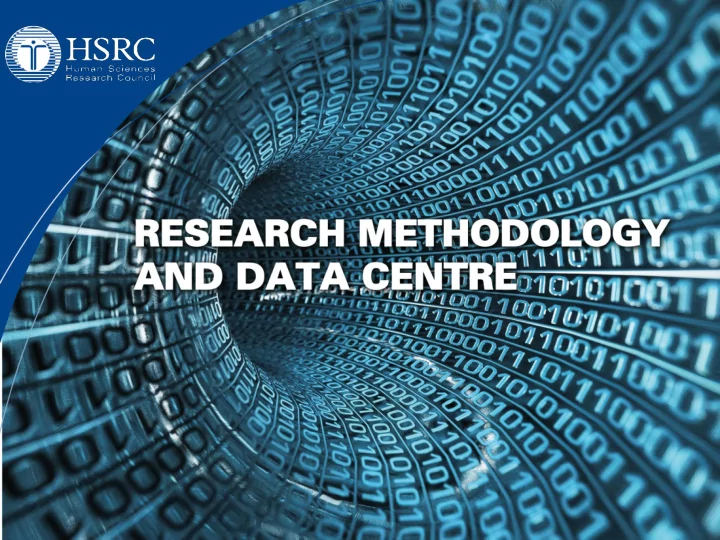

Social science that makes a difference
Geospatial technologies to the rescue: enhanced socio-economic research Gina Weir-Smith and Tholang Mokhele 26 October 2016 HSRC Seminar, Pretoria Social science that makes a difference
Outline of presentation • Purpose of presentation • Background • Visualisation • Sampling • Fieldwork mapping • Spatial analysis • Conclusion Social science that makes a difference
Background • GIS - a decision support system involving the integration of spatially referenced data in a problem-solving environment • An information technology which stores, displays and analyses both spatial and non-spatial data • True value of GIS lies in its ability to analyse spatial data using the techniques of spatial analysis • These are • Data visualization • Exploratory data analysis • Modelling Social science that makes a difference
Background cont. • Common applications • territorial control e.g. boundary survey data • natural resource exploitation e.g. vegetation and soil • socio-economic profiles e.g. population, housing, health, education, etc. • Monitoring • event monitoring e.g. crime, fire statistics, etc. • monitoring of environment e.g. wild life, air, soil and water data • Management and planning • natural resource management • infrastructural planning and service provision Social science that makes a difference
Visualisation • People remember • 10% of what they hear • 20% of what they read • 80% of what they see and do • Visual tools (imagery, maps and graphic products) are important to understand the complexities of spatial information • GIS integrates data from different sources • statistical databases • paper maps • surveys • remote sensing Social science that makes a difference
Visualisation cont. • Two types of maps • Topographic maps portray the earth’s surface as accurately as possible subject to the limitations of the map scale e.g. houses, roads, vegetation, relief, geographical names, and a reference grid • Thematic maps represent the distribution of a particular phenomenon e.g. crime hotspots, population density Social science that makes a difference
Visualisation cont. • How do I say what to whom? • ‘What’ = spatial data and its characteristics • ‘Whom’ = the map audience and purpose of the map • ‘How’ = design rules themselves Social science that makes a difference
Sampling Methods • Random sampling (Probability) • Simple • Stratified • Multi-stage • Non-random sampling (Purposive) • Systematic • Convenience • Snow ball Social science that makes a difference
Sampling cont. • Stage 1 - Province • Geo type, i.e. Formal, Informal, Urban, Rural, Farms • Stage 2 - Primary Sampling Units from Master Sample of 1000 EAs or Small Area Layer (SAL) • Sample unit-based sampling: points or polygons are selected from a sample frame • Stage 3 – Secondary Sampling Units – Dwelling Units/ Visiting Points/ Households from sampled EAs or SALs • Area-based sampling: Random points are generated within a polygon Social science that makes a difference
Sampling cont. • Dwelling unit frame data • Coordinates • Random selection • Imagery (raster) • GIS (vector) • Statistical software • Stata or SPSS Social science that makes a difference
Fieldwork mapping • Value of fieldwork mapping • Guide the Principal Investigators (PI) or planners with logistics • Assist and co-ordinate planning fieldwork trips • Assist fieldworkers with directions • Identify houses that need to be surveyed Social science that makes a difference
Fieldwork mapping cont. Social science that makes a difference
Fieldwork mapping cont. • Types and scale of fieldwork maps • National • Provincial • SAL/ EA Maps (these are detailed maps) • Overview maps • Street maps • Household maps or Visiting Points (VP) maps Social science that makes a difference
Fieldwork mapping cont. Social science that makes a difference
Fieldwork mapping cont.
Spatial analysis • Hot spot analysis • Identifies statistically significant hot spots and cold spots - Getis-Ord Gi* statistic • Warm values = similar and high • Cold values = dissimilar and low • Z score around zero = no apparent spatial clustering • Spatial concentration • Test spatial randomness of trends • Useful to identify spatial concentrations Social science that makes a difference
Social science that makes a difference
Spatial analysis cont. • 3D mapping • Visualize socio-economic phenomena • Highly graphical representation of spatial patterns, e.g. areas with high rate of poverty Social science that makes a difference
Social science that makes a difference
Spatial analysis cont. • Spatial autocorrelation (Moran’s I) • Considers feature location and attribute values • Is the pattern expressed clustered, dispersed or random? • Positive Moran's I index - tendency toward clustering • P-value refers to probability • Small value means very unlikely (small probability) that the observed spatial pattern is the result of random processes • Z-scores are standard deviations Social science that makes a difference
Social science that makes a difference
Spatial analysis cont. • Remote Sensing (RS) • The science of acquiring information about the earth’s surface from a distance, typically from aircrafts or satellites • Done by sensing and recording reflected or emitted energy and processing, analyzing and applying that information • Spatial and temporal dimensions • Spatial resolution • Temporal resolution • Linkages - GIS and RS Social science that makes a difference Social science that makes a difference
Spatial analysis cont. Social science that makes a difference
Conclusion • Relevance of geospatial technologies • GIS Centre provides spatial solutions to evidence based research • Power of location based solutions • Improved efficiency - undertaking empirical surveys • Sampling and mapping • Earth Observation • Robustness in data analysis • Spatial and inequality analysis • Integration of multi-disciplinary dimensions • Human Dynamics, Sustainable Development Goals Social science that makes a difference
Recommend
More recommend